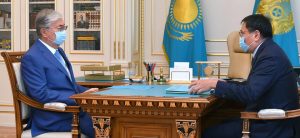With a problem like the COVID-19 pandemic, data is a refuge. Data tells us how worried we ought to be and what risks we can reasonably take; data factors into how we judge our governments for their actions. But the conclusions we draw from data are only as good as the data itself. And the collection and publication of data, especially about a contagious new disease, is fraught with difficulties both scientific and political.
Data, in many ways, has doomed Central Asia’s COVID-19 responses. Apparently manageable curves of cases early on and efforts to avoid “panic” have resulted in a devastating “second wave” of infections.
On July 17, Kyrgyz authorities reported 13,101 cases of the novel coronavirus since its first emergence in the country in mid-March. The next day, as a result of a policy change in what data was included in the official COVID-19 cases figure, that number nearly doubled to 24,606. It’s now 28,980.
A similar pattern could be seen in Kazakhstan’s COVID-19 statistics. After separating out asymptomatic cases in June, Nur-Sultan began including them again — leading to a jump in the topline government numbers.
Kyrgyzstan’s policy change, announced on July 16, was the inclusion of pneumonia cases consistent with the new coronavirus but without specific, tested confirmation in the official COVID-19 topline figure. The decision was hailed by Human Rights Watch, which said it “provides greater transparency and accountability and should improve their ability to protect people’s health.” The next day Kazakh authorities announced that beginning August 1, they too would begin counting pneumonia cases suspected of being linked to COVID-19 in the country’s official data. One can expect a massive spike to come.
Media reports indicate that the health systems in Kyrgyzstan and Kazakhstan are deeply strained by the influx in cases. Limited testing capacity has meant that some patients with COVID-19 symptoms die with just a pneumonia diagnosis before a COVID-19 test can be done or their sample tested. Acknowledging that reality and including such cases in COVID-19 data builds a more realistic picture of the situation, but the data-driven damage has, in many ways, been done.
The decisions to include pneumonia cases by Kyrgyzstan and Kazakhstan underscore a few stark realities.
First, states make policy decisions based on the data they’ve gathered and published; individuals also make decisions based on that information.
On May 11, Kazakhstan allowed its state of emergency to lapse and began allowing quarantine restrictions and curfews to be lifted in certain locations, based on data about case loads in those areas. Kyrgyzstan’s state of emergency lifted the same day. Both countries couched their policies and phased re-openings as based on the data.
Second, in portraying an air of calm and control — and attempting to censor or ban anything that could cause “panic” — regional governments did their citizens no favors in understanding the dire nature of the pandemic. Relatedly, who is punished for causing “alarm” seems to often be a clearly political decision.
In Kazakhstan, an activist was found guilty in late June of the “dissemination of knowingly false information that threatens public order during the state of emergency.” The activist, Alnur Ilyashev, had merely posted harsh criticisms of the government’s pandemic response on Facebook. Meanwhile, as Anastassiya Fershtey noted in a July 10 article for The Diplomat, conspiracy theories took over Kazakh social media even as a second lockdown loomed. Coda Story reported further this week about Kazakh celebrities promoting conspiracy theories to their followers. “Government censors have largely ignored such celebrity posts,” Katia Patin writes.
In an effort to avoid causing “panic,” governments overcorrected and didn’t do enough to underscore the severity of the pandemic threat to their citizens. The data they designed backed them up. Journalists in the region have observed a lack of urgency among many in public regarding social distancing and mask wearing. As in the United States, it’s arguable that such observations are at least partly linked to inconsistent national-level public health messaging. Why wear a mask in Kyrgyzstan, for example, in May after the state lifted restrictions and the head of the national center for the control of viral infections said the pandemic in the country had hit its peak in April?
Lastly, extant skepticism about government blooms in a crisis. In a May article for The Conversation regarding the ways Central Asia’s authoritarian governments were using the pandemic to their advantage, the authors, Saltanat Janenova and Jonathan Fisher, remarked that “there has been a gradual loss of public trust in Central Asian governments’ competence in recent years, resulting from weak policy implementation capacity, rampant corruption, and limited citizen engagement.”
As much as the pandemic feels disconnected entirely from time, all the circumstances that existed before remain in play. Governments suffering from weak policy implementation capacity can’t suddenly transform to become super-capable of implementing tough new public health policies and corrupt governments don’t suddenly become clean at a moment of crisis. The bottom line is that the problems that existed before the pandemic have been amplified by it.
As the saying goes, “There are three kinds of lies: lies, damned lies, and statistics.”
Statistics and the data that underlie them are easy to get wrong, maliciously or accidentally. It’s satisfying to cite data (I do it all the time), but the context in which the data is generated matters immensely. In Central Asia, the data has doomed state responses.
Eurasianet maintains an extremely useful graph of official case numbers in the Eurasian region. Viewing it now, you can see where policy changes spiked official case data in Kyrgyzstan and Kazakhstan. It’s hard to believe that if the region’s other capitals began reassessing, as Nur-Sultan and Bishkek have, what data they publish and what is included in the official COVID-19 statistics that Uzbekistan and Tajikistan would not see similar leaps.
Turkmenistan remains off the chart entirely, occupying a state of complete denial regarding COVID-19. That merely dooms a portion of its citizenry to death, uncounted.

































